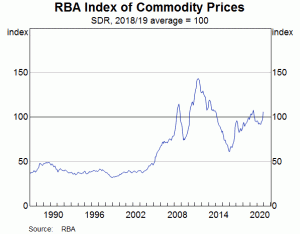Commodity prices have started 2021 the way they ended 2020 – on the up.
Iron ore, copper and gold all enjoyed solid rises, though oil eased.
The reasons for the rises were different – gold jumped on fears about the stability of US politics, iron ore jumped on demand, copper surged because of higher demand from China and others because of a spillover.
That was after the surge last year left a key measure of commodity prices – the Reserve Bank’s monthly commodity price index – at its highest level since mid-2019.
The index for December and 2020 in fact reflected the rebound from the pandemic driven lows of March and April, and subsequent rebound in the strength of Chinese economic activity and demand.
The index reflects the strength of demand from China for iron ore, copper and wool in particular which more than offset softness from other major economies..
The index for December and 2020 reached the highest level since August 2019, thanks to the rise in iron ore, wool, gold and copper prices.
The Reserve Bank said that the index rose 6.1% in December to be up 6.6% in Australian dollar terms for the full year.
That was in fact a rise of more than 15% if the near 10% rise in the value of the Aussie dollar against the greenback is discounted.

The Tuesday US trading session saw more of the same after OPEC and Russia did a deal on production cuts, Chinese steel mills lifted demand for iron ore and copper approached its latest highs.
Oil futures jumped by nearly 5% after the OPEC + deal. US West Texas Intermediate futures settled just below $US50 a barrel, their highest finish since February last year.
Brent futures rose by a similar amount to settle around $US53.50, also the highest prices have been since early 2020 prior to the impact of the pandemic.
OPEC and its allies (really, Russia), known as OPEC+, reached a deal on output curbs starting in February. Saudi Arabia will cut its output by a extra million barrels a day in February and March, as output quotas from Russia and Kazakhstan were increased by a combined 75,000 barrels a day.
“The breakthrough in relations between Russia and Saudi Arabia removes some of the downside risk to oil prices and could lead to continued strength as the global economy recovers later this year,” said Matthew Weller, global head of market research at GAIN Capital to Marketwatch.com.
February West Texas Intermediate crude rose $US2.31, or nearly 4.9%, to settle at $US49.93 a barrel on the New York Mercantile Exchange. Prices touched an intraday high of $50.20.
Meanwhile, iron ore and copper prices rose again on Tuesday as demand from China lifted prices higher.
At the same time Brazil’s economic ministry revealed a sharp, 33% jump in iron ore exports in December.
But while that seems impressive, it was off a low base in December 2019 as Vale, the huge Brazilian exporter, was struggling to bring mines in its southern complex back on line in the wake of the January, 25, tailing dam collapse and disaster.
The ministry said Brazil shipped 33.17 million tonnes of ore last month, compared with 24.99 million tonnes in December 2019. A more accurate guide would be the 33.19 million tonnes shipped in December, 2018, the month before the dam wall collapse.
On that basis there was no change in Brazil’s exports and in fact its share of global shipments has fallen in the two years as exports from Australia have risen.
The small 1.5% rise in global ore prices (to $US167.86 a tonne for 62% Fe fines delivered to northern China) on Tuesday adds to the confident start to 2021 on Monday when prices for 62% Fe fines were up 3%.
Copper prices meanwhile have also continued where they left off in 2020 – on the up.
LME three-month price settled at $US8,002 per tonne on Tuesday at the close, just a few dollars short of the 2020 high of $US8,028 a tonne reached on December 18.
Copper’s closing price on Tuesday was up 1.8% from Monday’s price of $US7,890.50, which was a 1.2% increase from the December 31 closing price, $7,766 a tonne.
In New York we saw a much bigger rise in Comex copper which lifted 2.77% to more than $US3.65 a pound.
Also on Comex, gold futures rose by around $US8 to settle around $US1,956 an ounce.
Gold was building on the previous day’s rise on worries about the state of US politics and especially the results of the two Senate run off polls in Georgia on Tuesday.
The strong rises in gold, copper and iron ore helped the ASX trim what was looking like a big loss on Monday to a dip of just 2.3 points or 0.03%. The futures trading had the ASX opening up six points on Tuesday (at 7.45 am).
Wall Street was back in the green but cautious ahead of the voting tonight (our time) in Georgia and then the interminable counting, recounting and Donald Trump-led whining and whingeing.







